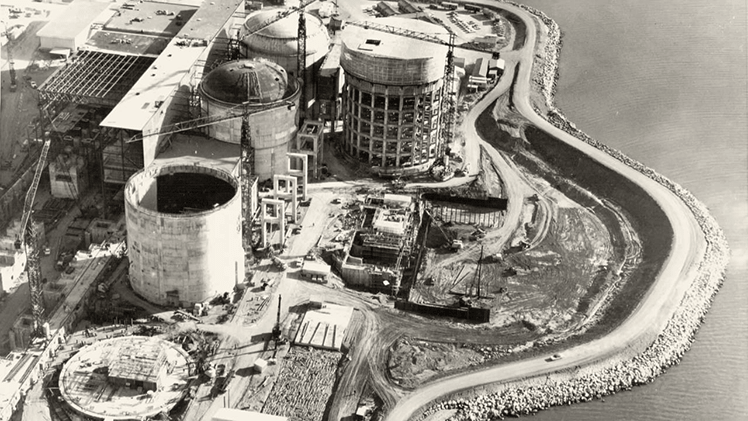Timeline: HTML Version

Dr. George C. Laurence
(1961 - 1970)
1961-01-01
George C. Laurence is appointed AECB President Dr. George C. Laurence becomes President of the Atomic Energy Control Board. He is instrumental in developing a safety philosophy for the design of nuclear reactors in Canada.
1961-11-13
The Tocsin B nuclear attack simulation is organized by the Canadian government A nuclear attack simulation, named Tocsin B, is broadcast across the country. Civilians listen to instructions at home while federal, provincial, territorial and municipal government officials coordinate communications and emergency systems. (Source: Canadian Broadcasting Corporation)
1962-03-01
The Cuban Missile Crisis brings the world to the brink of nuclear war The nuclear crisis reaches its peak when it is reported that missiles are poised to hit targets in North America from a launching pad in Cuba.
1962-06-04
The CANDU prototype starts operations Nuclear Power Demonstration – the first Canadian nuclear power reactor and the prototype for the CANDU design – begins operating in Rolphton, Ontario. Shortly after, the reactor delivers the first nuclear-generated electricity in Canada to the grid. (Source: Canadian Broadcasting Corporation)
1963-01-01

The Whiteshell RD centre is established in Manitoba The Government of Canada establishes the Whiteshell Nuclear Research Establishment (now Whiteshell Laboratories), a nuclear research and development centre near Pinawa, Manitoba, about 100 kilometres northeast of Winnipeg on the east bank of the Winnipeg River.
1964-08-20

Ontario announces construction of a multi-unit plant at Pickering The Ontario government announces plans to build a large, multi-unit nuclear plant in the municipality of Pickering. Today, Ontario Power Generation (OPG) owns and is licensed to operate the Pickering Nuclear Generating Station, located on the north shore of Lake Ontario. OPG also operates a nuclear waste management facility at the station.
1965-11-01

The Whiteshell reactor begins operations The Whiteshell Reactor-1 begins operating at Whiteshell Laboratories, demonstrating the feasibility of an organic-cooled CANDU power reactor.
1966-11-15

Douglas Point station begins operations The Douglas Point Nuclear Generating Station begins operating. It is Canada’s first commercial-scale nuclear generating station and a prototype for today’s larger nuclear power plants. In 1967, it begins to feed electricity to the grid, placing Canada on the world map of nuclear energy. In 1968, it is declared fully in service.
1968-01-01
New reactor opens to produce isotopes The Safe Low Power Critical Experiment (SLOWPOKE-2) reactor begins operating at Chalk River Laboratories. Some of its functions are to produce isotopes and conduct irradiation testing. CRL is one of the most complex laboratories in Canada, with activities ranging from services and development related to the nuclear industry, to other science areas such as physics, metallurgy, chemistry, biology, and engineering.
1966-11-15

Douglas Point station begins operations The Douglas Point Nuclear Generating Station begins operating. It is Canada’s first commercial-scale nuclear generating station and a prototype for today’s larger nuclear power plants. In 1967, it begins to feed electricity to the grid, placing Canada on the world map of nuclear energy. In 1968, it is declared fully in service.
1968-01-01
New reactor opens to produce isotopes The Safe Low Power Critical Experiment (SLOWPOKE-2) reactor begins operating at Chalk River Laboratories. Some of its functions are to produce isotopes and conduct irradiation testing. CRL is one of the most complex laboratories in Canada, with activities ranging from services and development related to the nuclear industry, to other science areas such as physics, metallurgy, chemistry, biology, and engineering.
1968-01-01

New reactor opens to produce isotopes The Safe Low Power Critical Experiment (SLOWPOKE-2) reactor begins operating at Chalk River Laboratories. Some of its functions are to produce isotopes and conduct irradiation testing. CRL is one of the most complex laboratories in Canada, with activities ranging from services and development related to the nuclear industry, to other science areas such as physics, metallurgy, chemistry, biology, and engineering.
1968-07-01
Canada joins 58 nations in signing the international Nuclear Non-Proliferation Treaty The Nuclear Non-Proliferation Treaty establishes commitments to prevent the spread of nuclear weapons, promote cooperation on the peaceful uses of nuclear energy and achieve nuclear disarmament. Under the NSCA and its regulations, Canadian importers and exporters are required to obtain and comply with CNSC licences controlling the international transfer of nuclear and nuclear-related items. Licensees must respect Canada’s nuclear non-proliferation commitments.
1969-01-01

The AECB adopts regulations for the transport of radioactive materials The Atomic Energy Control Board adopts regulations for the transport of radioactive materials. Today, all nuclear substances are transported in packages that are selected based on the nature, form and quantity or activity of the substance. There are general design requirements that apply to all package types to ensure that they can be handled safely and easily, secured properly, and are able to withstand routine transport conditions.
Page details
- Date modified: